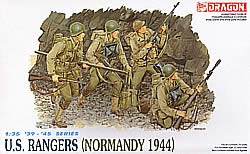|
U.S.
Rangers (Normandy 1944) |
 |
|
The Army Rangers had history before hitting the beaches of Normandy. Fifty Rangers joined in the ill-fated landing at Dieppe in 1942. The 1st Battalion distinguished itself in Tunisia in 1942. Under the overall command of Col. William Darby (portrayed in the James Garner film Darby's Rangers), this unit was joined by 3rd and 4th Battalions at Anzio. All three battalions were decimated in Cisterna, however. The 2nd and 5th Ranger Battalions were assigned to Omaha Beach in 1944 (the 2nd, of course, being the unit of Capt. Miller and his squad in Saving Private Ryan). Specifically, Task Force A was charged with taking the craggy heights of Pointe du Hoc and destroying the large German guns that, unbeknownst to them, had been moved further inland. Task Force B landed near "Dog Green" on the far right of the Omaha landing where they mixed with the 29th Infantry. Task Force C, consisting of the 5th Ranger Battalion and two companies of the 2nd Rangers, landed in the Dog Green and Dog White sectors with the 116th Infantry Regiment of the 29th Infantry Division. A major feature among the Rangers was an assault vest fashioned for the invasion. This vest had large breast and hip pockets, as well as two large pouches stitched onto the upper and lower back areas. Many people believe that only the Rangers were issued the vest. But as Jonathan Gawne reveals in his excellent Spearheading D-Day, vests were also issued to the 29th Infantry Division. Not every soldier in either unit received one, and some who did discarded their vests before they even got onto the landing crafts. The invaders were loaded down with an incredible amount of gear and ammunition, and fear of drowning under the excessive weight was not uncommon. And the vests show up very rarely in photos of the days following the landing because they were extremely hot to wear. As seen in the DML set, two of the GIs are equipped with the vest, which was either an olive drab 5 (khaki tan color) or olive drab 7 (green OD). The M1943 entrenching tool is hung over the upper back pouch. The other two soldiers wear the commonly seen M1926 haversack, with the M1910 entrenching tool tucked beneath the meat can pouch. The waterproof M7 gas mask carrier is worn either on the chest or strapped to the thigh. The M26 floatation belt is visible on three of the figures (again, another bulky item that not all soldiers used and those who did quickly abandoned on the beach). Because of these particular features specific only to the D-Day landings, it's difficult to adapt these figures. Beneath all their gear, they wear the M1941 field jacket, OD herringbone twill trousers with cargo pockets, and the combat shoe with canvas legging. One soldier carries a Bangalore torpedo, which was issued to soldiers in pairs (multiple sections could be connected together). The Bangalore could be capped with a rounded nose sleeve and slid forward along the ground to breach a 10' wide hole in a barbed wire entanglement. Only one section is present in the kit, but this is really not a problem as it is woefully underscale in both diameter and length—each section was 5' long and 2 1/8" in diameter. So replace the piece with appropriate length and thickness of plastic rod, rounding off one end and hollowing out the other end(s). Jonathan Gawne's book provides a good guide and photos of this explosive device. Otherwise, the soldiers are equipped with the standard M1 Garand (one with a grenade launcher), M1 Thompson submachine gun, and BAR. Paper straps are included for the M1 ammunition bags carried by the sergeant with the Tommy gun. This was the second set of GI figures issued by DML in 1994, and they still stand up well today (in fact, they stand up over 6'). The gear does not have the delicacy in sculpting that later is seen in later sets, but it's quite serviceable. This set, along with other U.S. infantry figures from the Normandy time period, was reissued by DML in 2004 with an additional sprue of retooled weapons and gear, as well as new heads with full hair (which still are not much of an improvement over the previous heads). These updated sets are marked with an emblem on the box top. I'd recommend checking out Archer Fine Transfers for the distinctive orange and blue Ranger insignia to apply to the helmets, as well as the rank patches to dress up your figures' sleeves. I helped Woody Vondracek design these when I was all fired up for a yet-to-be-completed Omaha Beach diorama. -tss- |
 |
 |
 |
 |
 |
 |
 |
 |
 |
 |
 |
 |
|
 Dragon
Models Limited
Dragon
Models Limited